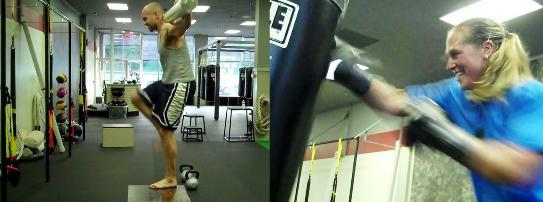How do you know you are wearing the right shoes?
by Rugged Coaches on 04/02/15
Contributed By: Coach Adel
We ask a lot from our feet: running, jumping, dancing, spinning and doing burpees. Shouldn’t we make sure our feet have what they need to do their job optimally? The type of shoes we wear should be determined by the activity we wish to engage in. It’s important to take into account your orthopedic history (any past injuries?), doctor prescribed inserts and your personal preference for shoe type (notice how I listed this last!). You may need to get custom made inserts, and that’s okay whatever keeps your feet and joints happy. Make sure to get them fitted to different shoes, so consult your podiatrist in case you use inserts or have a history of feet problems. Always check with your doctor before starting a new exercises or training program. We are now going to take a look at the three most common shoes we see someone wearing in our facility.
Cross training Shoes
Cross-training shoes or cross trainers is your “jack of all trades” shoes. They are the most frequent shoe we see and for good reason, they have enough flexibility in the material and arch support that they can be used for a variety of training classes and styles (Bootcamp, Running and Weightlifting). They combine a fraction of the cushioning from running shoes, the lateral ankle mobility from aerobic training shoes, and the flat heel of a weight lifting shoe. Those who participate in several types of classes or training modules would benefit from a cross trainer, instead of having a dedicated shoe for each training method. You can lift weights, run and or play sports in them.
Running Shoes
The running shoe made for running but can be worn to a group class in a pinch. Conventional wisdom has suggested the use of a running shoe with ample cushioning to absorb the shock on the pavement. There are those who are advocates for minimalist running shoes that have with almost no cushioning. No conclusive data exist to say which type of shoe is better, however the way you run or walk will vary dramatically depending on the shoe you wear. Conventional running shoes provided thick cushioning to the heel and mid foot, thus they can support a heel strike (heel makes contact with the ground first) running pattern. Minimalist shoes provided no cushioning and will result in pain and injury if you try and run with a heel strike pattern. Instead you must adopt a mid-foot to fore foot running pattern. This will allow the metatarsal area and your own arches to act as natural shock absorbers. If you don’t know what you’re running pattern is visit a local running shoe store that offers free video gait analyzes and running shoe fitting. If you are a frequent runner (3 or more times a week) , or run for extended periods of time its best to invest in dedicated pair running shoe. Running shoes can be worn to group training classes and be used for lifting weights; however they are not designed for this! They don’t provided the same lateral (side to side) stability as cross trainers, and the cushioned heel creates instability though your foot, and kinetic chain. Simply put running shoes are not the optimal option for group training, but they will do if you don’t wish to get a dedicated shoe.
Weight Lifting Shoes:
Weight Lifting shoes, like the name implies are dedicated to lifting weights. They provided a completely flat sole, plenty of friction (almost vacuum like to the floor) and a raised heel. You may ask why a raised heel? The raised heel creates additional mobility at the ankle joint, thus it dramatically improves your ability to squat or execute power lifts. Sounds crazy right! The next time you’re at the gym test this out by placing a 5 lb. plate underneath each heel, and then squat. You will notice how much easier it is to go deeper and maintain a more upright torso. Now weight lifting shoes are almost exclusively just good for lifting weights, kettlebells, or any activity with minimal running. Weight lifting might be for those who can’t attain the ankle mobility to properly perform squats, lunges or any type of loaded activity without significant compensation. The great thing about weight lifting shoes is that they last for almost ever; the shoe is typically made out of thick leather, and a wood or steal sole with rubber over it for stability.
Wear and Tear
How long can work out shoes last? Years? Wrong, workout shoes should be replaced frequently, how frequent will depend on the number of hours you work out, and the quality of shoe. A cheaper made show will break apart faster, the thread on the bottom will bald sooner; the arch and cushion will deform and deflate quicker. Typically the runners are advised to replace shoe wear every 300-500 miles, if you use cross trainers and don’t run as frequently look to change your shoes every 4-6 months, or based on the level of abuse you inflict on them.
Hope this helped you guys, feel free email me or any of the other coaches if you have any questions.




